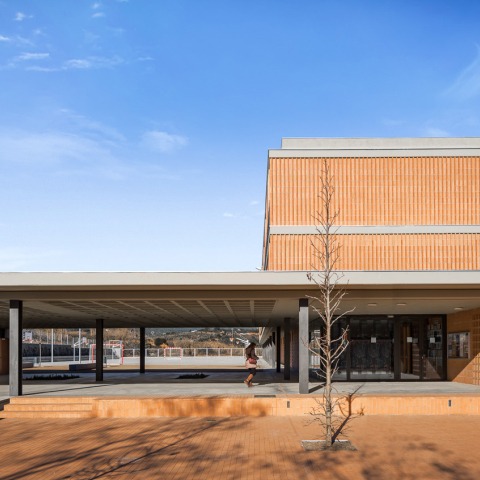The project generates a clean, tidy and well-articulated look characterized by the use of façade ceramics with various types of rigging, to generate different textures. The rest of the closures are made of glass, cellular polycarbonate and covered with pine in some areas of the ground floor. Sun protection is done based on adjustable ceramic slats.
Project description by Barceló Balanzó Arquitectes + Xavier Gracia
The new Institute is located on a plot at the edge of the housing area of the Aimerigues sector, on the threshold of future city growth and an area of parks of important dimensions limited by the street Icaria. The implementation is defined by the location of the building's volumes within the plot: a compact volume aligned on the street Pablo Iglesias and a smaller volume that contains the gymnasium and that defines the access through a public space and the porch. The typological model proposed is of a compact nature with a bright and generous central corridor, with classrooms on both sides. An economical, compact, flexible and efficient volume.
Economical, for its constructive simplicity and the square meters built in relation to the requested needs of the program. Compact, as it occupies less territory and frees up outdoor space with consistent measures for leisure activities, without residual spaces, facilitating the control of exterior space and allowing easy expansion. Flexible, the programs of the educative spaces have an important mutability and the operation of the centre requires great flexibility to accommodate different uses over time. Independent access is guaranteed for the gym, the library, the parent-teacher association, and the outside toilets, without having to enter the centre.
Efficient, its compactness helps to minimize energy losses. Optimum circulation and dry construction are passive systems that help reduce the building's carbon footprint. Reduction of the ecological footprint: use of non-polluting, durable and easily recyclable materials; use of renewable energy, control systems, waste management and use of BIM technology in the project and construction processes. The classrooms are arranged in the volume aligned to the street Pablo Iglesias, formalizing one of the limits of the centre without generating residual spaces. The gym is arranged facing the street Icaria, accompanying the access, with a space with trees that will serve for bicycle parking.
Between the two volumes a south-facing porch is generated, through which the institute and the gym are accessed. As for the materials, the use of ceramics on the facade with various types of rigging is used to generate different textures, making reference to the city's industrial architecture tradition. The rest of the closures are made of glass, cellular polycarbonate and covered with pine in some areas of the ground floor. Sun protection is realized based on adjustable ceramic slats that avoid direct radiation but allow diffused light to enter. Its height is adjusted to avoid direct sun but allowing the visibility of exterior views.



































